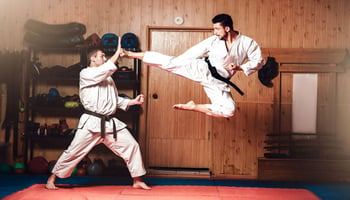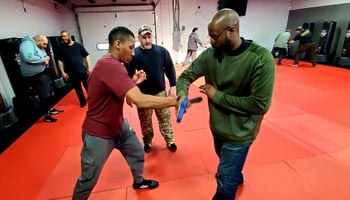This article aims to understand better the mentalities of criminals, their modes of operation, and...
What are the 5 Categories of Personal Safety?
Even many experts are unable to clearly explain the differences between self-protection, self-defense, martial arts, combatives, firearms, and the value of scenario-based training, which leaves most people seeking personal safety information confused about which one is right for them.
The terms are often used somewhat interchangeably, and while there can be some degree of overlap, they are distinctly different in their purposes and methods. The purpose of this post is to describe their various characteristics to clarify their differences and help people make better decisions about what is best for them.
What is self-protection?
Self-protection is a comprehensive approach to safeguarding one's well-being, encompassing a range of strategies, skills, and behaviors aimed at preventing harm and ensuring personal safety. This concept extends beyond physical defense and incorporates mental, emotional, and situational aspects of security.
Physically, self-protection may involve learning and practicing self-defense techniques to fend off potential threats. However, it also includes adopting a proactive mindset, situational awareness, and risk assessment to avoid or mitigate dangers before they escalate.
Emotionally, self-protection involves setting healthy boundaries, recognizing and managing stressors, and cultivating resilience in the face of challenges. Mental self-protection includes fostering a positive mindset, developing critical thinking skills, and making informed decisions to reduce vulnerability.
Situational awareness is crucial for self-protection, requiring an understanding of one's surroundings and potential risks. This awareness allows individuals to adapt to changing circumstances and make informed choices that enhance their safety.
In essence, self-protection is a holistic and proactive approach to personal safety. It empowers individuals to take charge of their well-being, equipping them with the tools and knowledge to navigate the complexities of life while minimizing risks and ensuring a sense of security in various aspects of their daily existence.
What is self-defense?
Self-defense is the practice of protecting oneself or others from physical harm or the threat of harm through a range of strategies, techniques, and awareness. Rooted in the fundamental right to personal safety, self-defense encompasses both physical and psychological aspects.
Physically, self-defense involves acquiring skills in techniques such as striking, blocking, and grappling to repel or incapacitate an assailant. Some, but not all, martial arts disciplines offer valuable training for effective self-defense.
Psychologically, self-defense includes cultivating situational awareness, maintaining a proactive mindset, and recognizing potential threats. The ability to assess and respond appropriately to danger is a crucial aspect of self-defense.
Legally, self-defense is often framed by the principle of using reasonable force to protect oneself or others when faced with an imminent threat. Laws regarding self-defense can vary, but the general idea is to allow individuals to protect their lives and well-being within the bounds of legality.
Ultimately, self-defense is not just a set of physical techniques; it is a mindset and a set of skills that empower individuals to navigate the complexities of personal safety, fostering confidence and resilience in the face of potential dangers.
What are martial arts?
Martial arts are diverse disciplines encompassing various systems of combat training and techniques developed for self-defense, physical fitness, mental discipline, and spiritual development. Originating from different cultures around the world, martial arts often carry deep philosophical foundations and ethical principles.
These practices can be categorized into striking arts (like Karate, Taekwondo, and Muay Thai), grappling arts (such as Judo and Brazilian Jiu-Jitsu), and traditional weapon-based arts (like Kendo and Escrima). Each martial art emphasizes a unique set of techniques, strategies, and values.
Beyond physical techniques, martial arts places a strong emphasis on character development, self-discipline, and respect for others. Many martial arts systems incorporate formalized patterns of movement called "katas" or "forms," which serve as a way to practice techniques, enhance muscle memory, and instill traditional values.
Martial arts training is not solely about combat; it's a holistic approach to personal development. Practitioners often experience improved physical fitness, increased mental focus, and a sense of inner peace. Many martial arts schools also promote a sense of community and camaraderie among practitioners.
Whether pursued for self-defense, sport, or personal growth, martial arts embody a rich tapestry of cultures and traditions, offering a path to both physical and spiritual enrichment.
What is combatives?
Combatives, also known as close-quarters combat (CQC), is a specialized training methodology focused on practical and efficient hand-to-hand combat techniques for self-defense and military applications. Rooted in the need for effective, quick responses in real-world scenarios, combatives draw from various martial arts, combat sports, and military training systems.
The primary goal of combatives is to equip individuals with skills that can be rapidly applied in close-quarters situations, where traditional martial arts techniques may be less practical. Combatives training includes striking, grappling, and defense against both armed and unarmed assailants.
Key features of combatives include simplicity, adaptability, and a focus on gross motor skills, making the techniques accessible and effective under stress. Training often involves scenario-based drills, emphasizing realistic situations to enhance situational awareness and decision-making.
While combatives have a significant role in military and law enforcement training, civilian self-defense courses may also incorporate combatives principles. The discipline underscores the importance of practicality, efficiency, and a proactive mindset in responding to threats, making it a valuable component of personal safety education in various contexts.
About carrying concealed firearms
Firearms, when used responsibly and legally, can be powerful tools for personal safety. The presence of a firearm can act as a deterrent, dissuading potential threats and providing a sense of security for the owner. Proper training is paramount for responsible firearm ownership, ensuring individuals are proficient in handling and using the weapon safely.
In situations where immediate self-defense is necessary, a firearm can be an effective means of protection. However, it is crucial to understand the legal implications, including local regulations on ownership, carry permits, and the use of deadly force. Responsible storage of firearms is also vital to prevent accidents or unauthorized access.
Firearms offer a level of force that can be commensurate with a serious threat, providing individuals with the means to protect themselves and their loved ones. However, the decision to own and use a firearm should be approached with careful consideration, an understanding of the associated responsibilities, and a commitment to ongoing training and education.
Ultimately, while firearms can play a role in personal safety, they should be part of a comprehensive approach that includes situational awareness, de-escalation skills, and an understanding of legal and ethical considerations.
In addition to tactical firearm skills (accurate shooting is not enough), responsible advocates of carrying a concealed pistol also train to gain important auxiliary skills such as firearm retention, safely accessing while under attack, defeating close-quarters knife attackers, and employing support items like flashlights, knives, and tactical pens.
Why is scenario-based training important?
When selecting a course, consider your mental and physical capabilities. It is vital to understand that “knowing” techniques learned in a stress-free environment with a cooperative training partner is a long way from “applying” them in actual circumstances under stress with an assailant intent on hurting you.
For this reason, scenario-based training is important. Scenario-based training is a form of instructional methodology that immerses participants in realistic situations to enhance their skills, decision-making abilities, and preparedness for specific challenges. This training approach is widely used across various fields, including military, law enforcement, emergency services, healthcare, and corporate environments. Note: the quality of the scenarios is directly proportional to the realism of the situation and assailants they portray.
Scenario-based training aims to provide practical experience and simulate real-world scenarios to better prepare individuals for potential situations they may encounter in their roles. It bridges the gap between theoretical knowledge and practical application, fostering a more comprehensive and adaptable skill set.
Tips for achieving the best possible outcomes
Because your well-being is at stake, it is important to know the differences between the five overall strategies as they exist along a wide spectrum of purposes and methods. The best one(s) for you depends entirely on the method’s approach and outcome that is in line with your personal values and purpose.
When developing a personal safety strategy, the best possible outcomes are achieved by being tactically sound and legally defensible requiring skills that span the three main phases of an assault with 1) pre-engagement skills that focus on avoidance strategies and escaping tactics (TrulySafer.com), 2) follow-up with engagement tactics to physically ward off or defeat an assailant (Amok.Global), and 3) complete your preparation with post-engagement training that address potential first-aid issues and interacting with first-responders (CarrySafer.com).



